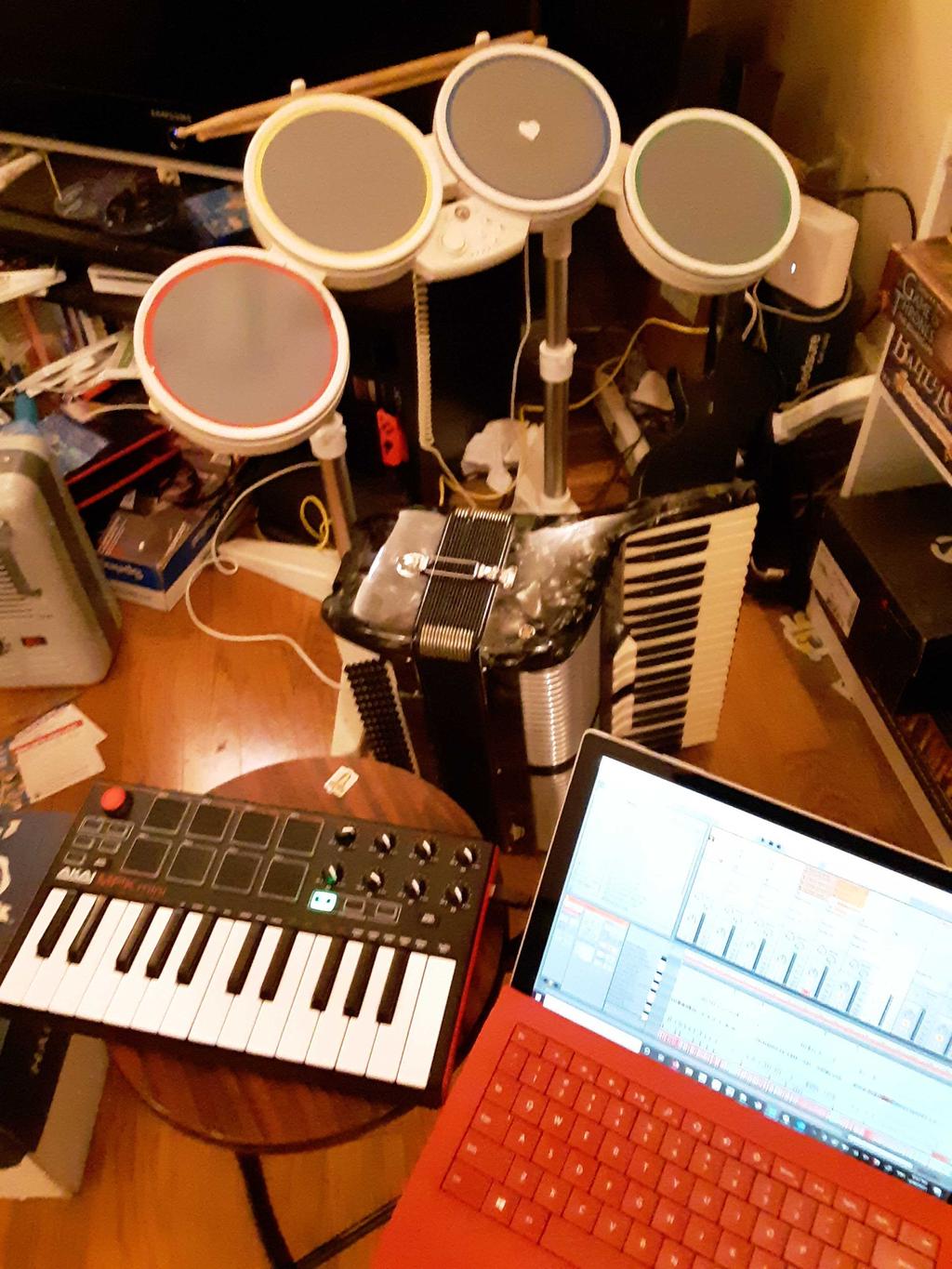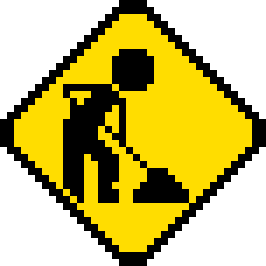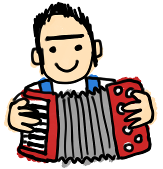I wrote a song! This is not the first song I've written, but it's the first one I've gotten to a complete enough stage to be comfortable sharing it with the internet.
It doesn't have a real title yet -- I might give it a title when and if I give it lyrics. The track is called "dirt" because I'm going for a down and dirty jazz/blues sound, and also because I've been thinking a lot about dirt lately as I work in the garden, and I have a lot of feelings about dirt, so maybe that's what the lyrics will be about.
Here's the instruments I used:

Pagani accordion, Wii Rock Band drums, Akai MPK Mini MIDI keyboard, Ableton Live.
Things I learned while making this song:
1. Keeping it simple, stupid
This song is traditional as can be. It's a standard swing jazz, 3/4 time, E-flat minor blues scale, with a head, bass solo, accordion solo, drum solo, and tail. The head and tail each consist of a main melody (A part), 8-bar bridge (B part), and then the A part repeated again with a slightly different ending.
The various unfinished songs that I'd been working on before this one all had much weirder musical structures, keys, rhythms, etc. I enjoy weird, fast, intense, complex music, like progressive rock and stuff. But the problem is, if I compose something weird and fast, then I'm not good enough to actually play it. And without a typical song structure as a template, it's hard to figure out how to transition between ideas. So all the weird stuff I was writing was not getting finished.
I realized I had a choice: either simplify what I was composing down to the level I can actually finish it and play it, or else give up on playing it and just program it into synthesizers. I chose to simplify.
2. Free Eductation
It's possible to get more or less a complete musical education from free YouTube videos. (I guess YouTube is actually good for something besides spreading conspiracy theories and radicalizing people, after all!)
For example, I don't know anything about playing bass, but I was able to follow Adam Neely's amazing instructions for walking a jazz bassline (using the MIDI keyboard to "play" the bass) and got something pretty serviceable.
His videos about jazz harmonies were also very helpful in figuring out my chord progression.
3. Soloing
I didn't even know this when I picked E-flat minor as my key (it just matched what I heard in my head) but E-flat minor turns out to be one of the easiest keys to solo in: its pentatonic scale is just the black keys. Throw in A natural and D natural and there's your minor blues scale. This means that when improvising, no black key is ever wrong with the chord. (I take advantage of this by doing a couple of glides on the black keys).
So I'm not actually following the chord changes in my accordion solo, I'm just relying on the power of the blues scale to sound good with anything. It's definitely soloing in "easy mode".
The ability to improvise a solo used to seem like magic to me. After a lot of practice, and learning some tricks like the above easy mode, it's feeling more achievable. There are three solos in this song, and while none of them is amazing, they're all mine. I'm proud to say each of them was a single-take solo (not the first take, but a single take) so all solos you hear are stuff I was really able to improvise in real-time. It's a tremendously good and empowering feeling to make something up as you play it and then say "hey, that sounded pretty good".
The way I've started thinking about soloing is that the length of the chord progression is 24 bars, and it takes about four bars to "say something" melodically, so in a solo I can "say" about six "things".
4. DAW editing / tech stuff
I learned how to set a swing percentage in MuseScore so the rhythm doesn't sound so robotic. (It don't mean a thing if it ain't got that swing!) And, how to export midi from MuseScore and import it into Ableton Live. Which is important, because MuseScore is much better for composing and Ableton is much better for producing. Also MuseScore produces printable sheet music for future reference.
Speaking of robotic-sounding rhythms: I learned how to connect the Wii Rock Band drums to my computer. (It's treated as a joystick, there's a utility called JoyToKey that lets you treat a joystick as a keyboard, and Ableton can take keyboard input as notes. So I can play the Rock Band drums and record them straight into Ableton with a little finagling. Only drawback is it doesn't capture the velocity of the hit, so all hits sound robotically identical. I discovered an Ableton midi effect to randomize velocity, which fixes this somewhat.
I also learned how to mix in Ableton Live by applying automation lines to the volume controls of each track, so I can turn down the other instruments during the bass solo, stuff like that.
(Ableton is like Photoshop: extremely powerful, but also extremely intimidating to learn -- I've only scratched the surface of what it can do.)
The drum sound I got is still not great, so I think my next step is to buy some proper electronic drums to use instead of the Rock Band ones.
5. Subtleties of the Accordion
I made some bad discoveries when recording the accordion parts.
I decided to use the Pagani instead of my more usual Sofia Marie (I own three accordions). The Pagani (which I purchased for a wad of cash out of the trunk of a guy's car in a Starbucks parking lot after making a deal on Craigslist) is a bit bigger and heavier, which is why I don't play it as much, but it has more octaves, more reed bank options, and I think a slightly nicer tone color.
But! oh no! The middle G-flat on my Pagani is out of key! But only on the in-stroke. When I'm pushing the bellows it's a little flat but when I'm pulling the bellows, it's fine. This ruined so many takes! I had to keep redoing it and timing the push/pulls so that I'd hit middle G-flat on the outstroke.
Another problem is that the microphone I have tends to pick up the right side of the accordion well, but the left (bass/chords) side comes out way too faint. I had to re-record the left hand parts with the microphone held right next to that side, and then mix them in Ableton. I think what I need to do next is get a proper set of pick-up microphones where I can tape one to each side of the accordion.
I learned a new chord in the process of making this song: the "minor seven flat five", AKA half-diminished chord. I love it, it's very jazzy and has a subtle, ambiguous, melancholy, questioning sound to it. I use F minor 7 flat 5 in the chord progression of the B section.
Problem: there's no button for it in the Stradella accordion bass button system, which only has dominant and full-diminished sevenths!
But I learned a trick! Which is that you play the minor triad that starts on the third, together with the counterbass button of the next row down. For F minor 7 flat 5, you play an A-flat minor triad with one finger and pick up the root from the counterbass of the D-flat row below.
I've been playing accordion (and taiko drums) for ten years now, but it's all been performing other peoples' songs. It's only in the last year that I've taken my first steps into making original compositions. I obviously have a lot farther to go, but I'm really excited. I'm overflowing with ideas for what to do next...

